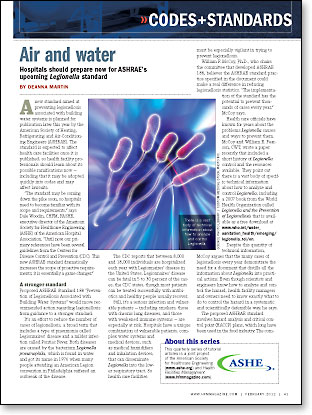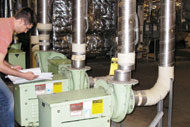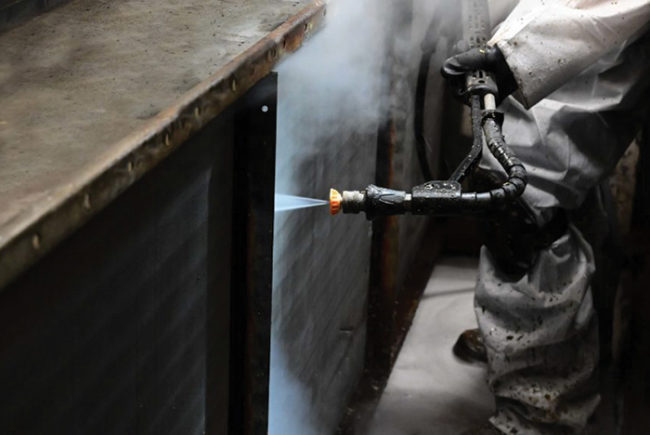 A new standard aimed at preventing legionellosis associated with building water systems is planned for publication later this year by the American Society of Heating, Refrigerating and Air-Conditioning Engineers (ASHRAE). The standard is expected to affect health care facilities once it is published, so health facility professionals should learn about its possible ramifications now — including that it may be adopted quickly into codes and may affect lawsuits.
A new standard aimed at preventing legionellosis associated with building water systems is planned for publication later this year by the American Society of Heating, Refrigerating and Air-Conditioning Engineers (ASHRAE). The standard is expected to affect health care facilities once it is published, so health facility professionals should learn about its possible ramifications now — including that it may be adopted quickly into codes and may affect lawsuits.
"The standard may be coming down the pike soon, so hospitals need to become familiar with its scope and requirements," says Dale Woodin, CHFM, FASHE, executive director of the American Society for Healthcare Engineering (ASHE) of the American Hospital Association. "Until now, our primary references have been several guidelines from the Centers for Disease Control and Prevention (CDC). This new ASHRAE standard dramatically increases the scope of proactive requirements; it is essentially a game changer."
A stronger standard
Proposed ASHRAE Standard 188 "Prevention of Legionellosis Associated with Building Water Systems" would move recommended action regarding legionellosis from guidance to a stronger standard.
It's an effort to reduce the number of cases of legionellosis, a broad term that includes a type of pneumonia called Legionnaires' disease and a milder infection called Pontiac Fever. Both diseases are caused by the bacterium Legionella pneumophila, which is found in water and got its name in 1976 when many people attending an American Legion convention in Philadelphia suffered an outbreak of the disease.
The CDC reports that between 8,000 and 18,000 individuals are hospitalized each year with Legionnaires' disease in the United States. Legionnaires' disease can be fatal in 5 to 30 percent of the cases, the CDC states, though most patients can be treated successfully with antibiotics and healthy people usually recover.
Still, it's a serious infection and vulnerable patients — including smokers, those with chronic lung diseases, and those with weakened immune systems — are especially at risk. Hospitals have a unique combination of vulnerable patients, complex water systems and medical devices, such as medical humidifiers and inhalation devices, that can disseminate Legionella into the lower respiratory tract. So health care facilities must be especially vigilant in trying to prevent legionellosis.
William F. McCoy, Ph.D., who chairs the committee that developed ASHRAE 188, believes the ASHRAE standard practice specified in the document could make a real difference in reducing legionellosis statistics. "The implementation of the standard has the potential to prevent thousands of cases every year," McCoy says.
Health care officials have known for years about the problems Legionella causes and ways to prevent them. McCoy and William E. Pearson, CWT, wrote a paper recently that included a short history of Legionella control and the resources available. They point out there is a vast body of specific technical information about how to analyze and control Legionella, including a 2007 book from the World Health Organization called Legionella and the Prevention of Legionellosis that is available as a free download at www.who.int/water_sanitation_health/emerging/legionella_rel/en.
Despite this quantity of technical information, McCoy argues that the many cases of legionellosis every year demonstrate the need for a document that distills all the information about Legionella into practical actions. Even though scientists and engineers know how to analyze and control the hazard, health facility managers and owners need to know exactly what to do to control the hazard in a systematic and scientifically defensible way, he says.
The proposed ASHRAE standard involves hazard analysis and critical control point (HACCP) plans, which long have been used in the food industry. The committee working on ASHRAE 188, called Standard Project Committee 188, chose the HACCP approach because of the success the food industry has had in implementing such plans and because HACCP training materials are available at little or no cost.
Steps for compliance
Complying with ASHRAE 188 involves several steps, according to the proposed document. They include the following:
- The facility is surveyed to determine its risk characterization, which determines what preventive measures are required under the standard.
- An HACCP team is formed by the building owner, the owner's building management team or both. The team must include at least one person who understands the principles of HACCP and at least one person who understands the building water systems. Members of the HACCP team can be employees, suppliers, consultants or any combination thereof.
- The team identifies the end point uses of potable and utility water systems within the facility.
- The team creates at least two process flow diagrams — one for potable water and another for utility water — to describe how the water is processed and used in their facilities.
- An on-site inspection confirms that the flow diagrams are accurate.
- Using the flow diagrams, the team identifies control points in the process. Control points are any steps at which biological, chemical or physical factors can be controlled.
- The team then determines which control points should be designated as critical control points, which are steps in the process where it is essential to prevent or eliminate a hazard or prevent harm to a person.
- The team establishes critical control limits for each critical control point. These are the specified values for hazard control, such as the amount of chlorine needed or the temperature range needed to control the hazard of Legionella.
- The team creates monitoring procedures for each critical limit as well as a monitoring frequency.
- The team establishes corrective actions to take when deviations from critical limits are found.
- The team validates its selection of critical control points, critical limits and corrective actions.
- The team establishes verification procedures and record-keeping procedures as required by the standard.
Clarifying the approach
The process may seem complex but the HACCP approach is clarified in a recent document produced by ASHE called "ASHE Recommendations Based on Proposed ASHRAE Standard 188P" and available at www.ashe.org/resources. For example, the diagramming system required under ASHRAE 188 does not have to be a complex engineering drawing, says John Collins, FASHE, HFDP, director of engineering and compliance for ASHE.
A simple block diagram would work if it shows control points where measures can be taken to eliminate, reduce or prevent the hazard from occurring. Using a simpler drawing can be a big help for health facilities, some of which may have complex water systems that were created 40 years ago when the facilities first were built.
The ASHE document also shows that critical control points in a hospital would be junctures where water enters higher-risk patient areas, such as transplant units, oncology units, critical care units and similar areas. A critical control point is any step in the process where hazard control is applied and validation is evidence that the hazard control has been effective. Therefore, a hospital facility team could designate that validation of the hazard control critical limit is no cases of legionellosis, Collins says.
Under that scenario, a hospital simply would create an HACCP plan to show how and where water is used in the facility and identify steps to take if a case of legionellosis is discovered. Then, if a case were discovered, the diagram would show the critical points for taking corrective action.
"The ASHRAE 188 standard is more manageable if you use this simplified approach," Collins says. "The standard is not as onerous as it looks at first glance."
ASHE is urging facility managers to learn about the standard now because of its potential for far-reaching implications once finalized. The ASHRAE standard is written in "code-ready" language, meaning it easily can be adopted into various codes with which health care facilities are required to comply. Even if the standard is not adopted immediately into codes, it could affect lawsuits regarding legionellosis cases, McCoy says.
It is often difficult to prove the source of Legionella in most single cases of infection, McCoy points out, so a strong defense by a hospital can be a powerful force as a jury determines whether a hospital is responsible for a case of legionellosis. McCoy says the committee was not tasked with determining whether ASHRAE 188 would be adopted into code or be used to defend against lawsuits by health systems using the process.
Hospitals often have a challenge in determining whether the disease was acquired in a hospital or the community because incubation periods vary in a hospital outbreak or cluster compared with community sources, even for susceptible patients. This standard is not aimed to measure that either.
At what cost?
The ASHRAE 188 committee was not tasked to develop a cost-benefit analysis, which ASHE requested in its initial public comments about the proposals. Instead, the committee was required to focus on gathering top experts in the field and getting a scientific consensus on the best way to prevent legionellosis associated with building water systems.
"We were asked to develop a strong technical consensus about what must be done to prevent legionellosis associated with building water systems," McCoy says.
ASHE members provided comments to the committee during the public comment cycle. ASHE requested the cost-benefit analysis because of the standard's far-reaching scope, which would cause it to compete for already scarce resources within hospital engineering and maintenance departments, Woodin says.
Without a cost-benefit analysis, Woodin worries that hospitals are shooting in the dark in trying to estimate the real cost of compliance and the proven benefit of the prescribed actions.
'No reason to delay'
While the full consequences of ASHRAE 188 are not yet known, some hospitals already are on board.
"Several major health care organizations are already implementing this process," McCoy says. "There's no reason to delay getting started using the standard practice specified in ASHRAE Standard 188."
To read the scope of ASHRAE Standard 188, check out the committee's Web page at http://spc188.ashraepcs.org/index.html or email ashrae@ashrae.org, where requests are routed to the appropriate staff member.
Deanna Martin is senior communications specialist for the American Society for Healthcare Engineering of the American Hospital Association. She can be reached at dmartin@aha.org.
| Sidebar - Some basic facts on Legionella |
| According to the Centers for Disease Control and Prevention (CDC) Legionella bacteria are found naturally in the environment, usually in water. The bacteria grow best in warm water, like that found in hot tubs, cooling towers, hot water tanks, large plumbing systems or parts of air-conditioning systems for large buildings. Legionella can cause Legionnaires' disease, which is a form of pneumonia with symptoms similar to other forms of pneumonia: high fever, chills and coughing. Chest X-rays are done to find the pneumonia caused by the bacteria and tests on phlegm, blood or urine can be performed to find evidence of the bacteria in the body. Most cases of Legionnaires' disease can be treated successfully with antibiotics, but the disease causes death in 5 to 30 percent of the cases in the United States, according to the CDC. Legionella also causes a milder infection called Pontiac Fever, which has symptoms including fever, headaches and muscle aches. Symptoms of Pontiac Fever go away on their own without treatment. Legionellosis is a broad term that encompasses both Pontiac Fever and Legionnaires' disease. People most at risk for legionellosis include those older than 50, current or former smokers and those who have a chronic lung disease such as emphysema. Also at increased risk are those with weak immune systems because of diseases like cancer, diabetes or kidney failure. Health care-associated cases of legionellosis make up a small percentage of the total number of reported cases, according to a 2007 publication from the World Health Organization (WHO). However, hospitals have a unique combination of vulnerable patients, complex water systems and medical devices, such as medical humidifiers and inhalation devices, that can disseminate Legionella into the lower respiratory tract. Because of these factors, the WHO report suggests that health care facilities have a special responsibility to prevent legionellosis. |





